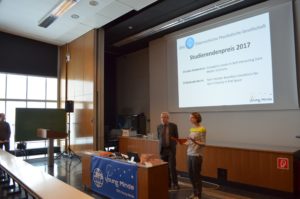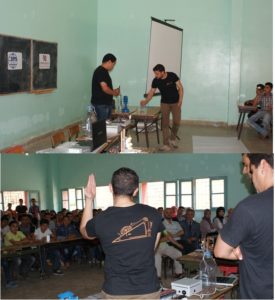 Mghila Béni Mellal USMS section has set up several activities during the 2017. First, visits to schools in Beni Mellal region and the realization of solar tracer project.
Mghila Béni Mellal USMS section has set up several activities during the 2017. First, visits to schools in Beni Mellal region and the realization of solar tracer project.
The focus of our activities is the transmission of technology to high school students and author people, and to show them how they can make practical works and technical projects with simple components and low cost.
First, we have visited a high school in AitAtab (Beni Mellal) and organizing a workshop of science and technology, in this workshop, we try to approach young minds students to technology and how to make a project with simple components and simple acknowledge. These projects are Cnc plotter, line tracer robot, robotic arm, alarm system. We have also visited another school in Fkih Beni Salh, where we organized a great event for more than 300 students from different levels. The objective of this event is show to student how to make a station to measuring some physical magnitudes, and use these measurements to make some simple project. For example Temperature measurement, this system is used to measure the temperature is composed by temperature sensor, Arduino board and an interface to visualize the results, we usually used LabViwe software. An author example is the radiation measurement this system is used to measure the solar radiation by using solar cells sensor.
The students shown great interest in the experiments and greatly thanked our visit, these students really got involved in the activities and due to that, we think they have learned many things. We considered this a very fruitful visit, were we gained also experience in presenting for large audiences.
The second Activity is the realization of a mono-axial solar tracker. The technique used for this study is based on the incident light difference on light-dependent photoresistor (LDR) sensors separated by opaque walls and placed on the PV panel. The control and control circuit performs the function of comparing the signals emitted by the sensors by calculating their differences, and then sends impulses back to the motor to reposition the panel perpendicular to the solar rays. We used in the realization of this project a stepper motor a support of two panels a control circuit composed of an Arduino acquisition card and two photoresistances.
Night events with DTU-Lys
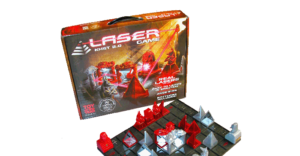 On November 28th 2017 in the evening, our student chapter DTU-Lys held a competition in the board game KHET, which is a complicated form of Chess, but with laser beams. Our student chapter owns 4 of these board games – a perfect number for hosting a competition with both group stages and knock-out rounds! The winner of the tournament was on beforehand promised a DTU-Lys t-shirt, which we had recently acquired a number of for outreach purposes. In total, this evening event numbered around 30 participants, with a good mix of Master students and PhD students.
On November 28th 2017 in the evening, our student chapter DTU-Lys held a competition in the board game KHET, which is a complicated form of Chess, but with laser beams. Our student chapter owns 4 of these board games – a perfect number for hosting a competition with both group stages and knock-out rounds! The winner of the tournament was on beforehand promised a DTU-Lys t-shirt, which we had recently acquired a number of for outreach purposes. In total, this evening event numbered around 30 participants, with a good mix of Master students and PhD students.
The evening started out with a 15 min introduction to our student chapter DTU-Lys, who we are, what we have done, and what plan to do. With the event taking place only half a month from our annual meeting and election in December, it was our hope, and plan, to lure in new potential active board members of DTU-Lys. Our current board now counts 4 new members who all participated in this event.
After the introduction, we divided people into four groups who were to play each other in order to decide who advanced from the group-stage and into the knock-out stage. We used chess-clock apps on our phones to make sure that the games did not continue in all eternity (this was an issue in the beginning) and to add an extra stress factor. During the night people had free access to beers and sodas, and after 1½ hour of playing everyone sat down and had pizza together.
All-in-all it was a very fun and social evening, and many of the participants urged us to organize a similar event in the spring 2018 – which we will certainly do!
Physics for High School Students
The Austrian section of EPS Young Minds (ÖPG Young Minds) and the Division “Physics and School” of the Austrian Physical Society (ÖPG) have organized this year’s “LehrerInnentag” (teachers’ day) of the Austrian Physical Society. We presented the winners of this year’s Students’ Award for outstanding master and diploma theses in the areas of theoretical and experimental physics, which is awarded by the Young Minds section. This year’s laureates are Lukas Semmelrock (HEPHY/TU Wien) for his work “Dissipative Losses in Self-Interacting Dark Matter Collisions” and Raphaela Wutte (TU Wien) for her work “Near Horizon Boundary Conditions for Spin-3 Gravity in Flat Space”.
Further, the division “Physics and School” presented the winners of the Roman Ulrich Sexl Award for outstanding achievements in teaching and the winners of the awards for “pre-scientific work” (“Vorwissenschaftliche Arbeiten”) in the area of physics.
Following the award ceremony, all laureates presented their areas of research in front of an audience of high school students. During the discussion many interesting questions were asked. Additionally, the participants of both the International Physics Olympiad (IPhO) and the International Young Physicists’ Tournament (IYPT) shared their experiences during these events.
With over 190 attendants composed mostly of high school students, teachers and other interested participants, the event was a great success. It connected graduate students and high school students and it helped introducing the latter to the forefront of research in modern physics. We definitely plan to repeat this event in the coming year.
Spreading Optics through the University
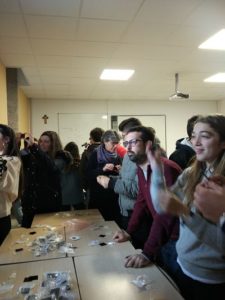 One more year, the USC EPS Young Minds Section devotes its efforts in outreach activities, focused in particular on the youngest. During this period, we have organised visits oriented to students of different local schools. The section members have gone to their classes and also the children have come to the Optics Faculty from University of Santiago de Compostela. In both situations, concepts explained to them were the same but the visit to the Faculty seems to be more enlightening due to the fact that they are able to visit the installations of the University as well as real Optics laboratory. Different research lines, where the YM Section members are involved, are shown to them and also the equipment of the laboratory and their basic functioning, such as pulsed lasers. The activities were distributed in four main blocks, as it was proposed in the Activity “Spreading Optics through the University” in the previous report. Nevertheless, the activity of holograms has been replaced for another one due to the material that was available in that moment. The performed activities were (1) polarization, (2) lens, (3) fluorescence and (4) refraction and reflexion. In (1), two little polarizers were given to the students to explain the concept, as well as a piece of a plastic fork to perform a tension essay using polarization. In (2), using a special kit of lenses and a schematic image of the human eye, myopia and hyperopia, as well as how they are corrected, were explained. In (3), we employed laser pointers, fluorescent markers, olive oil and gummies for explaining fluorescence and the light matter interaction. Finally, in (4) laser pointers, a methacrylate block and optic fibres were used. The main part of the budget has been employed in the bought of new material for the activities.
One more year, the USC EPS Young Minds Section devotes its efforts in outreach activities, focused in particular on the youngest. During this period, we have organised visits oriented to students of different local schools. The section members have gone to their classes and also the children have come to the Optics Faculty from University of Santiago de Compostela. In both situations, concepts explained to them were the same but the visit to the Faculty seems to be more enlightening due to the fact that they are able to visit the installations of the University as well as real Optics laboratory. Different research lines, where the YM Section members are involved, are shown to them and also the equipment of the laboratory and their basic functioning, such as pulsed lasers. The activities were distributed in four main blocks, as it was proposed in the Activity “Spreading Optics through the University” in the previous report. Nevertheless, the activity of holograms has been replaced for another one due to the material that was available in that moment. The performed activities were (1) polarization, (2) lens, (3) fluorescence and (4) refraction and reflexion. In (1), two little polarizers were given to the students to explain the concept, as well as a piece of a plastic fork to perform a tension essay using polarization. In (2), using a special kit of lenses and a schematic image of the human eye, myopia and hyperopia, as well as how they are corrected, were explained. In (3), we employed laser pointers, fluorescent markers, olive oil and gummies for explaining fluorescence and the light matter interaction. Finally, in (4) laser pointers, a methacrylate block and optic fibres were used. The main part of the budget has been employed in the bought of new material for the activities.
The activity has taken a very good reception from the students, due to its versatility and the self-made experimentation that they are able to do in each block. Also teachers consider an interesting activity because it is focused in science while it is very common to find activities focusing on Arts or humanistic fields in the surroundings. A prove of the success of the activity is the fact that last year schools ask for information to repeat the activity. In conclusion, we consider that this activity has enough impact to be done several times per year.
EPS YM recruitment social-evening “Go Fish for EPS-YM Members”
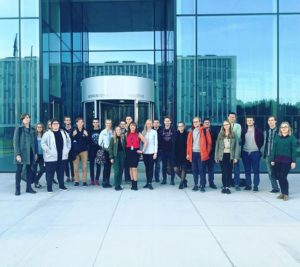 On October 18th European Physical Society Young Minds Section of Center for Physical Sciences and Technology (CPST) & Vilnius University (EPS YM Vilnius) together with SPIE and OSA student chapters (Vilnius) organized informational meeting for students from Faculty of Physics (Vilnius University). EPS YM Vilnius held recruitment event to encourage new members to join our chapter. CPST provided auditorium and basic equipment for presentations and meeting.
On October 18th European Physical Society Young Minds Section of Center for Physical Sciences and Technology (CPST) & Vilnius University (EPS YM Vilnius) together with SPIE and OSA student chapters (Vilnius) organized informational meeting for students from Faculty of Physics (Vilnius University). EPS YM Vilnius held recruitment event to encourage new members to join our chapter. CPST provided auditorium and basic equipment for presentations and meeting.
At the informational meeting EPS YM Vilnius chapter presented its main goals and activities. We presented a group of students from university and CPST, who assemble to organize activities related to the involvement with scientific community, promotion of science among local communities. We discussed with students about our events and events that we contributed to organize like International conference for students of physics and natural sciences “Open Readings”, “Sunrise Valley Semiconductor Seminars”, “10th Lithuanian Π day championship”, “Modern density functional theory – from physics to coding” workshops, workshops “What’s hot in the science publishing: the scientists’ approach”, etc.. We wanted students to learn more about the mission and vision of EPS YM.
The meeting was used to welcome, acquaint, inform, motivate, and engage new members. To illustrate how the Section operates, each our member has given a short overview. After presentation social-evening “Go Fish for EPS-YM Members” with pizzas has been organized at coffee house “Kino studija” (near the Faculty of Physics). Some of our members and chapter alumni told the students how EPS YM works, that we want to build a comaraderie around a shared passion. 8 students joined us. Our chapter wants to maintain strong and active. EPS-YM Vilnius set up and established a presence on a Facebook: https://www.facebook.com/EPSYMVilnius/
20 year anniversary
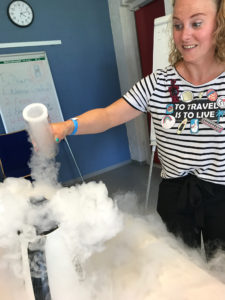 To celebrate the 20th anniversary of our foundation, we organized several activities for our members and for our contacts. We have organized a family-day, where the volunteers of our foundation had the opportunity to show what they have been doing to their parents and siblings. There has been a reunion for all the old members of the foundation and an almanac was made summarizing the past 5 years of our foundation.
To celebrate the 20th anniversary of our foundation, we organized several activities for our members and for our contacts. We have organized a family-day, where the volunteers of our foundation had the opportunity to show what they have been doing to their parents and siblings. There has been a reunion for all the old members of the foundation and an almanac was made summarizing the past 5 years of our foundation.
The family-day was a big success. As mentioned, all of the parents and siblings of the members were invited. We performed our Freezing Physics-show, the liquid-nitrogen-show that is traveling to high schools in The Netherlands to show that physics more than hard equations. The parents and siblings were also allowed to play with liquid nitrogen. A picture of an attendee (my own sister) is attached.*
The reunion was really fun and we think it was especially fun for our older members, most of them are not students anymore. There were also two of the founders at the reunion, which was a lot of fun for them. They didn’t know ‘their’ foundation still existed. A histogram is attached to show who were present at the reunion.*
We are very proud of our almanac. It cost a lot of work for the committee that was formed to produce it, but it was all worth it. Thanks to the Young Minds Grant it was possible for us to produce it for all of our members and contacts.
The family-day, reunion and almanac really made the 20th anniversary of the foundation an extraordinary year, for which we’re also thanking to the Young Minds Grant.
Get-Together-Meeting, Researchers Night and much more
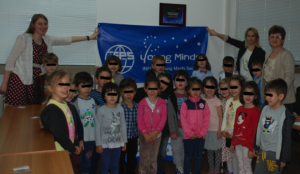 At the beginning of 2017, our newly formed section organized a Get-Together-Meeting, inviting the local SPIE and OSA chapters to present its proposed activities for 2017 and to extend an invitation to join the INFLPR YMS.
At the beginning of 2017, our newly formed section organized a Get-Together-Meeting, inviting the local SPIE and OSA chapters to present its proposed activities for 2017 and to extend an invitation to join the INFLPR YMS.
In February, our section has been invited by the Former President of the Romanian Physical Society to attend the meeting organized by the EPS-EC and EPS-CEI, taking place in Bucharest. This event presented great occasion for our section to be introduced to the public. The President and Vice-President of our section participated at the meeting, presenting the 1st Announcement of the sections’ international student conference, thus delivering the information to many EPS Member Societies.
Throughout the year, the INFLPR YMS organized laboratory visits at the National Institute for Laser, Plasma and Radiation Physics for kindergarten, primary, middle and high school pupils, thus providing participants an insight of the current scientific work carried out in the institute, and in the same time encouraging them to choose a career in research or academia. The President of the section also arranged small physics experiments, providing simple and concise explanations regarding fundamental physics phenomena in a funny and interactive way. It also has to be mentioned that in 2017, for the first time, INFLPR opened its doors for foreign students and their teachers from Germany.
Furthermore, a representative of the INFLPR YMS had the chance to attend the 6th Young Minds Leadership Meeting, organized in Naples, Italy, during 12-13 May 2017. He had the opportunity to make new connections and to advertise our student conference.
The INFLPR YMS was proud to organize together with the local OSA and SPIE chapters IONS® Balvanyos 2017, representing on one hand a huge commitment and responsibility, while on the other hand an incredibly worthwhile experience. IONS® Balvanyos was a memorable conference for all of us with high quality scientific program, opportunities to meet and discuss, as well as a truly enjoyable woodland experience. The conference was held at a geographically unique and vibrant resort in the heart of Transylvania’s Eastern Carpathian Mountains, near Lake Saint Ana, the only volcanic lake in Romania. IONS® Balvanyos brought together 65 participants from 10 different countries. Our generous partners and sponsors, including EPS as well, allowed us to offer Travel Grants to 18 students. The event didn’t lack of social activities, such as icebreaking games, field trip, playing Frisbee and campfire. The most courageous attendees also could take part in “bear watching”.
Moreover, the INFLPR YMS participated at Researchers Night in Bucharest, involving physics related experiments and providing visitors with funny and friendly explanations. Another aim of our participation was to promote and bring into the public attention the section and its activities.
Last but not least, at the beginning of 2018 our section launched a photo contest. Youngsters are asked to capture the beauty of science. With the help of the photo contest, our section will try to address people with various background and interests, showing the intertwining fabric of science and arts.
Day and night physics
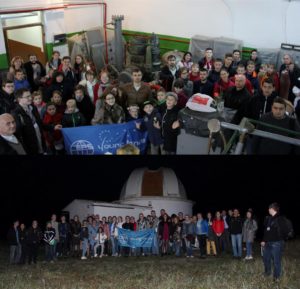 In the middle of autumn, Lviv Young Minds Section both with the Faculty of Physics of the Ivan Franko National University of Lviv organized a science communication event “Day and night physics”. Weather conditions forced us to split this event into two parts: “Night physics: astronomical observatory” (October 17, 2017) and “Day physics: Sunday of experiments” (October 22, 2017). We were close to our main purpose – popularization and promotion of science within an audience of different age – than ever.
In the middle of autumn, Lviv Young Minds Section both with the Faculty of Physics of the Ivan Franko National University of Lviv organized a science communication event “Day and night physics”. Weather conditions forced us to split this event into two parts: “Night physics: astronomical observatory” (October 17, 2017) and “Day physics: Sunday of experiments” (October 22, 2017). We were close to our main purpose – popularization and promotion of science within an audience of different age – than ever.
“Night Physics” is four similar night excursions to the suburban observation station of the Astronomical Observatory of the Ivan Franko National University of Lviv, where participants were briefed on history of the observatory and its equipment, history of astronomical studies in Ukraine, modern world’s largest telescopes, most significant discoveries in the last 15 years. The participants were told about the structure of the telescope and observed the night sky (Saturn and Pleiades using the telescope and famous constellations). Each excursion lasted for more than 1 hour. We rented a bus for four groups of visitors. Participation was free of charge and with prior registration. The total number of visitors is aroud 120.
“Day Physics” is an event rich in entertaining experiments and demonstrations. Therefore, visitors could see what physicists are doing in the daytime and try themselves as researchers. The concept of the event was quite simple: 6 areas of physics, respectively, 6 laboratories, parallel sessions, 4 hours. Participation was free of charge and without prior registration.
Laboratory of Radioengineering prepared experiments involving electric spark, a Hall sensor, lasers, electromagnetic induction, investigation of different signals using a computer and a USB oscilloscope.
Laboratory of Low-Temperature Physics demonstrated nanostructures, experiments with liquid nitrogen and helium, the superconductor levitation.
Laboratory of Optics demonstrated diffraction, interference, geometric optics, polarization, luminescence, holography.
Laboratory of Metal Physics showed the Brownian motion, series of experiments concerning pressure changes, how to synthesize a magnetic fluid and control it using electromagnets.
In the Laboratory of Astrophysics, participants made their own star chart, learned how to use it.
Also, the Laboratories of Theoretical Physics and Optics have prepared interactive parts. Theoreticians helped participants to make the pendulum of Capitza, a cloud in a bottle, the easiest analogue of a non-Newtonian and magnetic fluid, etc. Opticians concentrated on different aspects of luminescence, game of light and colorful shadows.
The series of experiments were repeated like sessions in a cinema, according to the schedule. Long demonstrations in the Laboratory of Low-Temperature Physics were repeated 2 times. Interactive parts continued without interruptions. All other laboratories repeated 30-min. demonstrations 5 times.
The total number of visitors is around 350.
Pizza Physics & Beer
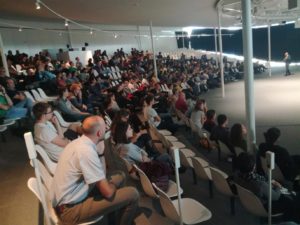 The EPFL Young Minds section expanded with success during the last year. As planned, monthly seminars were organised under the label ‘Pizza Physics Beer’ (PPB). We noted a steady number of participants ranging from 30-45 during the past semester. We are now 8 students fully invested in the organisation of the PPB meetings and other events.
The EPFL Young Minds section expanded with success during the last year. As planned, monthly seminars were organised under the label ‘Pizza Physics Beer’ (PPB). We noted a steady number of participants ranging from 30-45 during the past semester. We are now 8 students fully invested in the organisation of the PPB meetings and other events.
The subjects covered in the PPB meetings were: nuclear fusion, with a visit to the Tokamak reactor at EPFL; surface treatments to create ultra hard materials; safety measures regarding fission nuclear reactors, and the risks associated with human failure; the fabrication of anti-hydrogen at CERN; correlated dynamics in quantum systems; the use of perovskites for optoelectronic applications; the social behavior of solitons in microresonators.
This seminars were attended by PhD students from the whole EPFL Physics PhD Doctoral School (EDPY) as well as curious master students. This allowed some interaction between students, both during and after the seminar. The after-seminar gatherings lasted, in some cases, more than one hour.
We successfully organised the physics day: a major event that took place on October 16 at the Rolex Learning Center, EPFL. The four speakers of this event included the Nobel prize winner in chemistry, Stefan Hell, as well as three other prominent physicists (L. O. Silva, P. Hazzi, A. Kellerer). This event was also the occasion of a poster competition between the physics PhD students and fostered interactions among physicists of the physics doctoral school of EPFL.
Rogerio Jorge, the association’s secretary, attended the leadership meeting of the EPS Young Minds associations in Naples, bringing a large number of innovative ideas to develop within the coming years, including “Physicist Speed Dating” and “Recruiting Event” activities. This first year, made possible by the EPS grants, was clearly encouraging. It reinforced us in our goal to make the EPFL physics community more interactive both within EPFL and with other members of the EPS community.
Training the next generation of physicists: outreach toward secondary schools
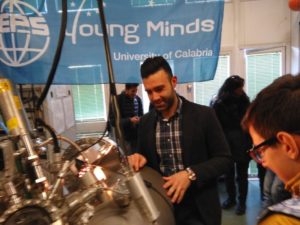 This activity has comprised both visits of students to University of Calabria, Department of Physics and, moreover, visits of members of the YM section to secondary schools.
This activity has comprised both visits of students to University of Calabria, Department of Physics and, moreover, visits of members of the YM section to secondary schools.
Concerning the visits to University of Calabria, students have been involved in simple demonstration of Raman spectroscopy and diffraction experiments with electrons and X-rays. In particular, students have understood how it is possible to recognize the different atomic components in an unknown material. Moreover, they have been introduced into crystallography with simple and funny demonstrations.
The visit to the Department of Physics has been organized thanks to the crucial support of local municipalities, that have kindly shared school buses to transport students to University of Calabria in Arcavacata di Rende (CS).
The visit to University of Calabria has been an occasion to give students the first contact with University and to explain them research at our Department of Physics with simple words.
We have shown them some prototypes of devices fabricated at our Department.
As regards the simple experiments carried out directly at secondary schools, we have tried to simplify as more as possible the concepts in Physics.
As an example, we have provided a direct demonstration of the Archimedes’ principle, with very simple equipment. We have tried to demonstrate that it works on both gaseous and liquid environments, by changing our experimental setup.
We have emphasized the importance of Archimedes’ principle with many examples from our daily lives. We have also stimulated the students to imagine a world where the Archimedes’ principle could not exist.
Moreover, we have built a lemon battery, with the direct participation of students. The goal of making a lemon battery is turning chemical energy into electrical energy, creating enough electricity to power a small LED light or a watch.
Students have experienced and successively realized (with the help of a short and simple explanation) that the source of electric energy in this demonstration is the combination of copper and zinc strips in the citric acid of the lemon.
We have used a multimeter to measure the voltage with one lemon and then again as we added more lemons.
Finally, it is worth mentioning that, throughout the entire duration of the activity, we have discussed with interested students about the various possibilities of carriers in Physics.
We thank the teachers of secondary schools for their kind collaboration.

